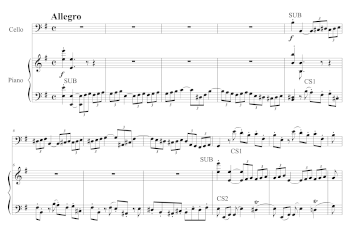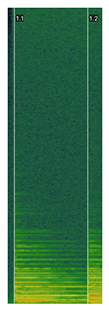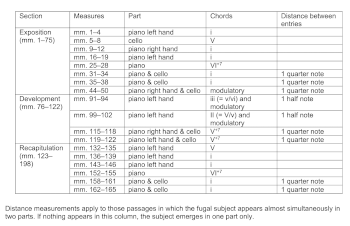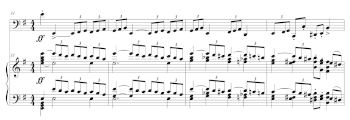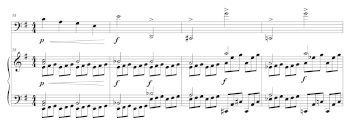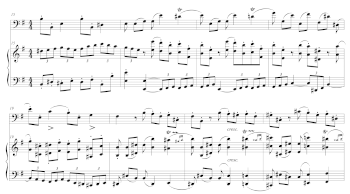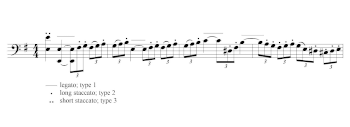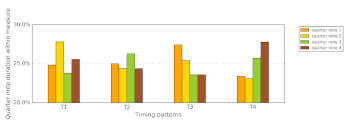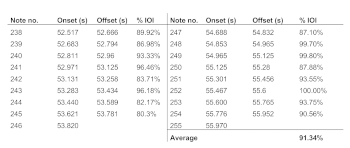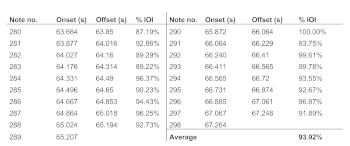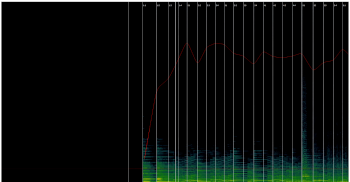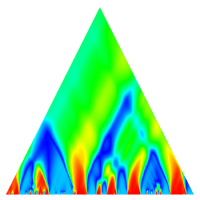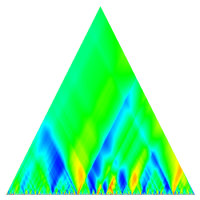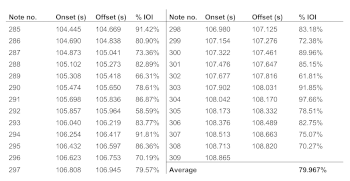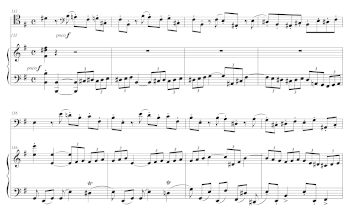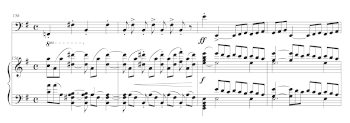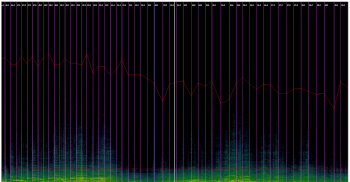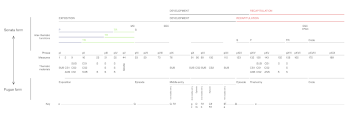Brahmsian Articulation: Ambiguous and Unfixed Structures in Op. 38
Ana Llorens
KEYWORDS: articulation, structure, performance analysis, Brahms, sonata form, formal inference, functional transformation, timing, dynamics, recording
ABSTRACT: The analysis of the structural repercussions of musicians’ strategies has traditionally focused on their handling of timing and dynamics, not only because of the correlation found in performances between hierarchical phrase structure and coordinated decreases in both parameters—usually referred to as phrase arching (Gabrielsson 1988) or phrase-final lengthening (Todd 1985; Repp 1990—but also because of these parameters’ easier quantification. However, other parameters, including articulation, can play equally significant roles in the emergence and potential perception of musical structures. The processes of performance and inference are, moreover, so unique to each musician and/or beholder that revisions of traditional approaches to musical form have become necessary. To explore this phenomenon, I study both the score and five recordings of the finale from Brahms’s first cello sonata, op. 38. The junctures where the transition and the recapitulation start are indeterminate. In addition, the piece employs procedures typical of both the sonata and the fugue to produce a formal hybrid that poses significant quandaries to both performers and analysts. Focusing on the selected musicians’ manipulations of articulation, this article aims to determine whether this parameter might, along with timing and dynamics, be relevant in the emergence and perception of formal relations. The study also addresses the ways in which formal ambiguity can be materialized, concealed, and created in performance, ultimately investigating how musical form can, on the basis of its performance, be considered as multivalent.
DOI: 10.30535/mto.27.4.7
Copyright © 2021 Society for Music Theory
[1.1] As the field of musical performance studies has evolved over the last twenty years or so, an increasing body of work on the structural impact of musicians’ decisions has developed.(1) Theorists tend to agree that musicians guide listeners’ perception of musical structure by engaging with surface detail. Musicians primarily disclose their structural interpretations of scores through their moment-to-moment manipulations of the parameters of sound (Bayley 1996, 300; Leech-Wilkinson 2012, [4.9]), in particular tempo and dynamics.(2)
[1.2] In part due to their more complex and context-dependent nature (Cogan 1984; Khoo 2007), other domains such as articulation and timbre are difficult to measure empirically. As a consequence, not only theoretical considerations, but also technological issues contribute to the predominant analytical focus on timing and dynamics. Most scholars studying articulation simply extend analytical methods originally devised for timing and dynamics (Bayley 1996; Dodson 2002; Drake and Palmer 1993; Fabian 2017; Leong 2019; Lester 1995; 1998). Even analysts who acknowledge the potentially structural role of articulation mainly study it on the basis of composers’ notation (Bayley 1996, esp. 129–240 and 316ff.). One exception is Fabian and Schubert (2008), who explore dotting and its effect on the perception of musical character. For her part, Fabian (2015, 184–90; 2017, 205–42) relates articulation to bow construction, notational ambiguity, meter, timbre, and more general issues of performance style.
[1.3] Theorists also traditionally assume that performers are preoccupied with conveying musical structure, as inferred from a composer’s score (Lester 1995, 203; 1998, 10). Performers may, however, understand structure in alternate ways,(3) perhaps more along the lines of “design” (Dunsby 1995), “quasi-structure” (Dunsby 2009), “shape” (Cone 1968; Berry 1966; Prior 2018; Rink 1990, 2004, 2015; Stein 1962),(4) or “dramatic form” (Agawu 2008). By the same token, the structural relations that they infer from composers’ scores may not influence the ways in which they play or sing. They may want to conceal or even dispense with structural relations determined from score analysis (Vande Moortele 2009, 311–12),(5) instead creating structures that may not be apparent analytically (Dunsby 1995),(6) sometimes through specific performance “motives” (Eitan 2003; Rink 2015; Rink, Spiro, and Gold 2011; Spiro, Gold, and Rink 2010). In this manner, musical performance studies challenge the validity and viability of restrictive conceptions of musical structure, above all those that accept structure as predetermined by composers in terms of pitch and metrical properties (Whittall 2001).
[1.4] Acknowledging (as I do here) that performers can play a role in how we understand and represent “structure” (assuming we wish to retain that term) effects a reconception of the notion of structure itself.(7) Musical structure has long been understood as multivalent. Performed musical structure, too, depends on a multiplicity of parameters and affords multiple interpretations and applications.(8) As a result, various performances can project different, even analytically surprising, structures in a single score (Barolsky 2008; Llorens 2018; Rink 2015).(9) As Leong states, “structure broadly defined is essentially plural. It constitutes open networks, in which various structures can interact and can be incongruent with one another” (Leong 2019, 10). Such openness is particularly true of the selected recordings of the third movement from Brahms’s Sonata for Piano and Cello, no. 1 in E minor, op. 38 (1865), which is my focus here. In this work, structural ambiguities—or, perhaps better termed, multivalences—inherent in the movement make the piece an ideal case study for exploring divergent approaches to sectional division and formal function.
[1.5] To explore the potential effects that performers’ articulation techniques may have in the inference of structural relations, I have selected five recordings of Brahms’s op. 38, iii from the ca. 250 that are available. The performing pairs, cellist and pianist, are 1) Pierre Fournier and Wilhelm Backhaus (1955); 2) Pau Casals and Mieczysław Horszowski (1958); 3) Mstislav Rostropovich and Rudolf Serkin (1983); 4) António Meneses and Maria João Pires (2013); and 5) Asier Polo and Eldar Nebolsin (2019). Their performances pose musical/analytical issues which, first, may not come to light when analyzing the score (Barolsky 2007; Bayley 1996, 316ff.) and, second, may not be understandable through phrase arch theory only (Dodson 2011, 22–23).(10) Most importantly all the performers in these recordings foreground articulation, sometimes at the expense of dynamics and timing’s formal implications. In response, this article’s approach to analysis regards articulation as a primary, structural parameter.(11)
Interpretive Concerns in Brahms’s op. 38, iii
[2.1] With the understanding that performance issues will soon come to the fore, we nevertheless begin with a brief examination of the score of Brahms’s op. 38, iii. This is done to place the selected recordings in a broader context and introduce some necessary terminology. It further reenacts part of the process of performance itself, in which interpretation typically develops by taking in the composer’s score. In a similar vein, the following analyses take as their point of departure the quandaries that the score of the Allegro third movement from Brahms’s E minor cello sonata poses to its performers, whether or not they are explicitly aware of them. Just as performers’ decisions are often provisional and subject to reflection over time as they live with the work, some of my preliminary conclusions will be revised. Similarly, some theoretical discussions will emerge later and more organically, in response to analysis of a given recording. By adapting these approaches, I aim to bring theory and practice into closer dialogue.
Example 1. Brahms, op. 38, iii, mm. 1–11
(click to enlarge)
Example 2. Brahms, op. 38, iii, formal ambiguity
(click to enlarge)
Example 3. Brahms, op. 38, iii, mm. 53–56; second theme group (S)
(click to enlarge)
[2.2] Brahms’s op. 38, iii is here classified as a movement in sonata form with two differentiated theme groups: P (E minor, m. 1ff.) and S (G major, m. 53ff.).(12) P presents a fugal subject (SUB) with two countersubjects (CS1 and CS2) (Example 1),(13) the SUB being based on Contrapunctus XIII from J. S. Bach’s Art of Fugue.(14) The harmonic movement in mm. 1–24 delineates the standard pattern of tonic-dominant-tonic (Example 2).(15) After motivic manipulation, Brahms presents the subject over the natural sixth scale degree in m. 25. The beat displacement with respect to the original entry in m. 1 prompts a metric acceleration towards m. 31. The subject re-enters there, realigned with the notated meter and over the tonic harmony, simultaneously in both recto and inverted forms. For its part, S has a more lyrical and tranquillo character (Example 3). The two theme groups are connected through a transition (TR) that ends in an elided III:PAC MC (Horton 2017).(16) Even with the PAC enhancing the fusion between TR and S (TR↔S) (Caplin 1998, 203),(17) the exposition, which is not repeated,(18) in principle conforms to the traditional view that the two theme groups in sonata form contrast with one another.(19) After the animato development section (m. 76ff.), a “reordered,” “reversed,” or “mirror” recapitulation (Jackson 1996, 1997; Rosen 1988; Vande Moortele 2021) starts with S over the principal dominant harmony (m. 123ff).(20) P (m. 132ff.) and TR are subsequently recapitulated over the tonic before the più presto coda (m. 175ff.).
[2.3] Yet, the authoritative tone adopted above for relating the form of the piece belies many of its ambiguities. In fact, Brahms’s piece posits analytical challenges at various structural levels. Such include:
- The formal weighting of the manifold appearances of SUB;
- The idea of theme groups within sonata forms as opposed yet structurally balanced elements, which in turn may influence the location and function of the transition; and
- The conception of the piece as an example of “reordered” sonata form.
[2.4] Each of the duos approach such challenges through different performative means, yet all of them use articulation first and foremost to convey their views, or what I believe their views to be. Even more than tempo and dynamics, the perception of articulation is at least partly mediated by unique perception thresholds that encompass a wide range of factors including speed (attack and release rate), the technology used while recording and/or listening, personal preferences and responses, performance experience, etc. In other words, do we all define legato playing in the same way? How do we explain how we differentiate empirically between spiccato and staccato in string playing? Why do some performers play a specific passage with longer bow strokes or with less pedal than others? Because of such variations, my interpretations to follow are based on both my personal impressions and measurements made on spectrographic images.(21) (They are, in other words, the interpretations of a trained listener with many years’ experience in playing Brahms’s op. 38, which are further guided and confirmed by empirical observations.) My listening impressions have guided the analysis by directing the attention towards specific effects, yet they have never determined it. In fact, there have been many cases in which conflict has arisen between my perception and the measurements. (Similarly, readers’ perceptions of the selected recordings may differ from the conclusions I present in this text.) In such moments I give preference to the measurements made on the spectrograms, prompting me to reflect on the validity of exclusive empirical analysis when it comes to performance.
Example 4. Type 1 articulation: legato; as in Brahms, op. 38, iii, Meneses (cello) and Pires (piano), m. 55
(click to enlarge)
[2.5] Empirical analysis helps us avoid unsupported, wholly subjective claims. To analyze articulation quantitatively, I employ a method uniquely geared towards this parameter. The method recognizes three broad categories of articulation depending on the relative sustaining of the lower partials, i.e., those up to the second octave from the fundamental frequency; these are listed below. Such requires manually measuring the percentage of the inter-onset interval (IOI) during which each note is held. The divergent classification criteria for the piano and the cello reflect the percussive quality of the piano, in contrast with the cello’s bowed and, thus, more easily sustaining nature (Llorens 2018, 109–10):
- Legato: “successive notes in performance [are] connected [virtually] without any intervening silence of articulation” (Chew 2001). In this type of articulation, the spectrographic image shows that the lower partials are maintained for over 95% of the IOI in the case of the cello, and over 90% in the piano (Example 4).(22)
- Long staccato: in the spectrograms, the lower partials are seen to be sustained for over 75% of the IOI in the cello, and over 70% in the piano (Example 5).
- Sharp staccato: clearly disconnected notes (Boyden and Walls 2001). It is visible when the spectrogram shows low overtone sustainment below 75% of the IOI in the cello and below 70% in the piano (Example 6).
To diminish the amount of numerical data in the article and thus to facilitate reading, I frequently transcribe the results in the form of specific symbols for legato (—), long staccato (·) and short staccato (··) in conjunction with staff notation. For the occasions in which my initial perceptions did not coincide with the empirical results, I also provide specific measurements of onset and offset times and percentage of the IOI.
Example 5. Type 2 articulation: long staccato; as in Brahms, op. 38, iii, Fournier (cello) and Backhaus (piano), first quarter note of m. 1 (click to enlarge) | Example 6. Type 3 articulation: short staccato; as in Brahms, op. 38, iii, Rostropovich (cello) and Serkin (piano), first quarter note of m. 5 (click to enlarge) |
[2.6] Despite the primary concern with articulation in the recordings, I do not discount the effects that timing and dynamics have on the creation, projection, and inference of musical structures. To nuance phrase-arch theory and the effects of performers’ group-final lengthenings (GFL), i.e., the ritardandos that they frequently employ at the end of the musical phrases,(24) I refer to Dodson’s (2002) idea of “phenomenal micro accents.” In that article, Dodson claims that, along with metrical accents and similarly to metrical and prolongational reductions, “phenomenal” micro accents ultimately yield a sense of emphasis on specific moments in the musical flow. As such, “hesitations” (analogous to GFL) as well as “elongations”—i.e., agogic emphases at downbeats—may serve as cues in the inference of phrase structure.
[2.7] Small-scale performative patterns have been shown to play a critical role in performers’ musical structuring (Rink 2015; Rink, Spiro, and Gold 2011). To further probe such micro-scale techniques, I performed Kohonen-network analyses (Spiro, Gold, and Rink 2010) on the five recordings. These computer-assisted(25) analyses serve to organize and cluster the data in the form of recurrent patterns. Applied to audio data, they help to determine which specific timing and dynamic patterns the performers use, in which measures the patterns surface, and their relative prominence. In this way, such patterns can be viewed as performance “motives” that emerge across the recordings analyzed and that may serve as a “link between structure and expression” (Eitan 2003, 213). Importantly, the patterns determined by such Kohonen analyses do not typically reflect precise measurements that are repeated exactly; rather, they usually concern general, average profiles (i.e., proportional increases and decreases in timing and dynamics), to which the actual performances conform. The software, further, does not place the detected patterns in the context of the large-scale tempo and dynamic fluctuations, hence the need for careful evaluation.
Example 7. Example of the input data for the Kohonen analyses of timing values in Viscovery SOMine
(click to enlarge)
Example 8. Example of the input data for the Kohonen analyses of dynamic values in Viscovery SOMine
(click to enlarge)
[2.8] To perform the Kohonen analyses, in each recording I measured the duration in seconds and the dynamic level in dB of each quarter note beat.(26) I manually tapped the recordings, aligning the vertical lines with the spectrographic images for enhanced accuracy. Data on tempo and duration at the quarter-note level were extracted, as well as smoothed values for dynamics. Dynamic values were then aligned with the position of the quarter notes using the online application Dyn-A-Matic.(27) To find patterns of equal length, I grouped the measurements by the largest common unit possible. In this case, it was by measures, as not all the phrases in Brahms’s op. 38, iii are divisible by larger units. The computer is trained using tabular data either on the durational percentage that a quarter note occupies within its measure (Example 7), or on the dynamic fluctuation from every quarter-note beat with respect to the following one (Example 8). After the training stage, the software returns a description and a bar graph of the patterns found and a list of where these patterns are found in the recording(s). As mentioned above, the program does not consider larger-scale fluctuations; it explores only beat-to-beat differences. In all cases, I experimented with carrying out the analyses with different degrees of precision. As the resultant patterns were always congruent with one another, I opted to present the data obtained with the two precision degrees that gave the most clearly interpretable results: medium (1000 nodes in normal mode) and high (2000 nodes in accurate mode).(28)
The Articulation of the Fugal Subject
Example 9. Brahms, op. 38, iii, recognizable appearances of the fugal subject throughout the movement
(click to enlarge)
[3.1] The first issue that performers may face when approaching the movement is the pervasive presence of the fugue subject throughout, as it continuously appears in complete, abridged, metrically displaced, or intervallically-modified fashion in both instrumental parts (Example 9). Moreover, at the start of both the development (mm. 76–79) and the coda (mm. 175–179), Brahms develops at length SUB’s triplet figuration, causing the performers’ potential focus on extending the initial articulation to those passages as well. Notably, the metric emphasis on the tied quarter notes on the second beats is inherited from the first movement, where the piano accompaniment in P counteracts the strong beats of the measure, further extending articulation preoccupations beyond the limits of the movement.
Example 10. Brahms, op. 38, iii, Rostropovich and Serkin; articulation of the fugue subject at the main structural junctures
(click to enlarge)
[3.2] Some performers seem to choose to be more “faithful to the score” (Goehr 1992, 231; Doğantan-Dack 2012, 9), i.e., to Brahms’s consistent notation of the fugal subject, with various combinations of short and long slurs, staccato dots, sf markings, and occasional legato writing. As an example, Rostropovich and Serkin (Rostropovich and Serkin 1983) invariably(29) accentuate the initial quarter note of SUB and then detach it from the one on the second beat (articulation types 2 and 3, as classified above). They then link the tied quarter notes of those second beats to the ensuing triplet eighth notes (articulation type 1). These eighth notes, for their part, are always played in long staccato strokes under articulation 2 (Example 10). In mm. 1–4, 31–34, 91–94, 99–102, 115–118, 119–122, 132–135, 136–139, and 152–155, the musicians employ a sharp staccato articulation (type 3) for the initial quarter note of SUB, whereas on the other occasions they resort to articulation 2 for that note. That is, the shorter type of articulation is perceived to signal the most important structural junctures: the starts of P and the “merged” TR in both the exposition and the recapitulation, as well as every time the material appears in the development.(30) This topic will be discussed below; see ahead to Figure 25c for a fuller contextualization.
Example 11. Brahms, op. 38, iii, mm. 31–34; start of the “merged transition” according to sonata theory
(click to enlarge)
[3.3] The start of the transition zone also projects ambiguity. On the basis of sonata theory, one may view m. 31 (Example 11) as the start of a “merged” transitional unit (TR) extending the activity of the first subject: its initial measures present the SUB in both recto and inverted forms simultaneously, dissolving itself “mid-phrase into transitional procedures” (P→TR) (Hepokoski and Darcy 2006, 94).(31) TR, starting in m. 31, involves a “functional transformation,” as described by Horton (2017, 176; 2019, 52–56)(32) and Martin and Vande Moortele (2014, 134). On the basis of its initial failure to modulate in its first seven measures, it is possible to divide it into two modules. The first module in mm. 31–37 would “become” the second half of a compound P, being interpretable as ultimately thematic (P←TR).(33) The second (mm. 38–52), which initially seems to be part of P, becomes a transition because of the modulation process (P→TR) (Horton 2014, 194–95; 2017, 175–77; 2019, 52–56).(34) In this manner, the two modules can also be seen to form a single unit with a double function from beginning to end (P↔TR) (Martin and Vande Moortele 2014, 147–49).
Example 12. Brahms, op. 38, iii, mm. 38–41; start of the transition according to Jackson 1996
(click to enlarge)
Example 13. Brahms, op. 38, iii, mm. 15–22; start of the transition according to 1972
(click to enlarge)
[3.4] Numerous authors locate the start of TR elsewhere. As S starts in m. 53, Timothy L. Jackson (1996, Example 5a on p. 76) reduces the “bridge” to m. 38ff. (Example 12)—note the coincidence with the internal division for the TR according to Horton’s theory. For his part, Pascall appears to view either m. 16 or m. 20 as the start of an “extensive bridge passage” (1972, 152) (Example 13).(35) Although these views of TR do not fit well within a sonata theory framework, support can be found through analysis of articulation in the selected recordings. As we will see, some of the performers emphasize structural articulation at precisely those junctures, this emphasis in turn having greater implications for the structural shaping of the movement.
[3.5] Polo and Nebolsin (2019), in contrast to Rostropovich and Serkin, appear to actively seek articulatory variety in the movement. In general, they play the initial quarter note of P with a sharp staccato (type 3) articulation, yet they do not always connect the quarter notes on the second beats to the ensuing eighth note triplets. The triplets, in turn, always receive articulations 2 and 3 (with no clear pattern as to which will appear.) Moreover, these performers are unique among the selected duos in employing a fourth type of articulation for the eighth note triplets. On occasions, they slur the first two eighth notes of the triplet, detaching the third. This 2+1 articulation occurs at the start of the piece (mm. 1–4; Example 14), the beginning of the development (mm. 76–79), and the end of both P and TR in the recapitulation (mm. 152–155 and 162–165) (Example 25, e).
Example 14. Brahms, op. 38, iii, Polo and Nebolsin, mm. 1–4; articulation of the fugue subject (click to enlarge) | Example 15. Brahms, op. 38, iii, Casals and Horszowski, timing patterns detected with medium precision in this recording only (click to enlarge) |
[3.6] In Casals and Horszowski’s recording (1958), the timing strategies are largely responsible for the tight aural correspondence between the emergences of P in mm. 1–3 and 132–134. A Kohonen analysis of the agogic fluctuations in the rendition determined four timing patterns (Example 15).(36) Among them, T1C/H shows moderate agogic emphasis on the second and fourth quarter notes of the measure; T2C/H has special emphasis on the third quarter note; T3C/H depicts a marked initial elongation; and T4C/H delineates a measure-long ritardando.
[3.7] Even though mm. 132–134 recapitulate mm. 9–11, the performers use the same durational profile as in mm. 1–3: T3C/H–T1C/H–T1C/H. The sequence recurs unchanged in mm. 31–34 and 175–177; that is, at the start of the “merged TR” and the coda. In this manner, this duo signals four significant demarcations through the same agogic means. Based on these agogic patterns alone, the performers subdivide the exposition into P (mm. 1–30), TR (mm. 31–51), and S (mm. 52–75).(37)
Video Example 1. Brahms, op. 38, iii, Casals (cello) and Horszowski (piano), mm. 1–40: recording and spectrogram visualization
(click to watch video)
[3.8] Casals and Horszowski similarly use an array of different articulations for the manifold appearances of SUB. In mm. 1–4, the pianist mainly plays in legato and long staccato (articulation types 1 and 2), yet in m. 8 the cellist enters in short staccato. In m. 25 again, Horszowski uses a longer articulation (type 1; Example 16)(38) that continues well into the “merged TR” (mm. 31–34; Example 17). This legato articulation culminates in m. 38ff. (the start of TR according to Jackson 1996, or of the second module of the TR according to Horton; Video Example 1). There, Casals delays the entrances of the notes, thereby creating an expressive sense of asynchronization between the two parts.(39) In the subsequent stretto imitations (m. 44ff.), the cellist and the pianist again use a staccato articulation, and, by m. 49ff. the legato character is perceptible. In declining to honor the staccato dots that Brahms annotated in m. 31ff. and 61–64, they create two large-scale articulatory progressions within the exposition that proceed from staccato to legato (Example 25, b).
Example 16. Brahms, op. 38, iii, Casals (cello) and Horszowski, mm. 26–27, piano part: onset, offset, and IOI measurements for each triplet eighth note (click to enlarge) | Example 17. Brahms, op. 38, iii, Casals (cello) and Horszowski, mm. 31–32, piano part: onset, offset, and IOI measurements for each triplet eighth note (click to enlarge) |
The Opposition and (Im)Balance between the Two Theme Groups and the Role of the Transition Zone
[4.1] Despite the pervasive presence of the fugal first theme throughout the movement, the second theme group in m. 53ff. stands out due to its tranquillo character, slurred writing, and more melodic facture, in both the exposition and the recapitulation. Performers may play both themes in similar ways or, less surprisingly, strengthen their textural and emotional contrast through performative means; in fact, they might even play them differently in each of the rotations of the form. Such approaches may in turn have consequences for the large-scale balance of the movement, as we shall see, and equally for the understanding of the transition zone as a thematic-functional unit.
[4.2] Pierre Fournier and Wilhelm Backhaus’s approach to the relation between the two theme groups of the piece is unique in that they play none of them in the recapitulation as they did in the exposition. In the exposition’s first rotation, they articulate P and S very sharply. They resort to articulation type 2 in P, although sometimes the cellist plays in short spiccato values (type 3). In S, they accentuate the note onsets, the cellist’s vibrato is not easily noticeable, and the partials’ content is comparatively reduced. Contrastingly, in the recapitulation, both S and, strikingly, P are played cantabile and legato: Fournier’s vibrato is ample, wide, and slow, and the amount of overtones is remarkably rich. Through these means, they seem to create two unified, opposite blocks.
Example 18. Brahms, op. 38, iii, Fournier (cello) and Backhaus (piano), timing patterns detected with medium precision in this recording only
(click to enlarge)
[4.3] This unifying approach to the movement is reinforced by the performers’ handling of timing. They avoid strong internal punctuations by keeping both tempo and dynamics stable. While doing so, they resort to relatively strong initial agogic accents and to GFLs to reinforce specific boundaries. Among the three timing patterns detected in their rendition (Example 18), T2F/B displays the strongest initial elongation, whereas T3F/B most clearly reflects GFL.(40) Through the use—or avoidance—of T2F/B and T3F/B, P in the exposition and S in the recapitulation are more perceptually segmented, whereas S in the exposition and P in the recapitulation are phrased in longer units.(41) With regard to articulation, in the exposition P leads with its staccato articulation; in the second, S’s more lyrical character prevails. In summary, the various thematic materials are played with varying articulations and are thus perceived as structurally different:
- P in the exposition: staccato and segmented
- S in the exposition: staccato and unified
- S in the recapitulation: legato and segmented
- P in the recapitulation: legato and unified (Example 25, a).
P and S, then, do not diametrically contrast with one another; rather, they adapt themselves depending on the order in which they appear within each rotation. This strategy impacts the TR too: in the exposition, m. 31 is more clearly demarcated through microtiming and articulation strategies than in the recapitulation.
Video Example 2. Brahms, op. 38, iii, Fournier (cello) and Backhaus (piano), mm. 1–75, recording and superimposed tempo curve
(click to watch video)
[4.4] Such demarcation may also be perceived when listening and following the tempo curve (Video Example 2). An analysis of phrase-arching yields similar results: as the smoothed timing scape plot(42) shows (Example 19), in the exposition the fluctuations form numerous arches in P, whereas S appears to be less segmented. Note that when enlisting the same color scale for representation, the raw, non-smoothed data reveals the opposite result, in which P and S as equally segmented (see the various blue flames for S in Example 20). This raises several questions. Should we not dispense with listening when empirically analyzing performances? How reliably do correlation techniques or other statistical operations express the intuitions developed by listening? Do smoothed data always correspond to such intuitions more closely than the raw, beat-to-beat data?
Example 19. Brahms, op. 38, iii, Fournier (cello) and Backhaus (piano), scape plot: smoothing = 0.1 (click to enlarge) | Example 20. Brahms, op. 38, iii, Fournier (cello) and Backhaus, scape plot: smoothing = 0 (click to enlarge) |
Example 21. Brahms, op. 38, iii, Rostropovich (cello) and Serkin (piano), mm. 53–54, cello part: onset, offset, and IOI measurements for each triplet eighth note
(click to enlarge)
[4.5] A lack of contrast between P and S is similarly perceptible in Rostropovich and Serkin’s rendition. Like Fournier and Backhaus, they play S in a detached style similar to that of P (type 2; Example 21)—despite the slurs on the score. Specifically, in m. 53ff. the cellist’s continuous changes in the speed of the vibrato (which is generally limited and, on some notes, virtually nonexistent) and the portato style in the bow produce an initial accentuation in each note. These effects could be heard as breaking the continuity of the line (Clarke 1988, 20), suggesting a similar articulation for P and S.
Example 22. Brahms, op. 38, iii, Meneses (cello) and Pires (piano), dynamic patterns detected with high precision in this recording only
(click to enlarge)
[4.6] António Meneses and Maria João Pires (2013) on the contrary play the two theme groups in dissimilar ways. The Kohonen analysis revealed four dynamic patterns in this recording (Example 22).(43) D1M/P delineates a decrescendo followed by a relative dynamic emphasis at the end of the measure; D2M/P shows the opposite pattern, i.e., a crescendo followed by a dynamic decrease; D3M/P delineates a more abrupt dynamic emphasis for the third quarter note of the measure, with a natural diminuendo thereafter; and D4M/P has a progressive crescendo with marked emphasis on the even-numbered quarter notes. Significantly, Meneses and Pires use all these patterns in S, yet in P and TR they never resort to D4M/P.
[4.7] This duo plays staccato only in P, whereas S, in contrast, receives a cantabile articulation throughout. Pires avoids any clear accentuation, especially in mm. 53–54. Given the “reordered” nature of the recapitulation, the two performers create a sort of mirror-like construction for the two rotations: staccato (P)–legato (S) in the exposition and legato (S)–staccato (P) in the recapitulation (Example 25, d).
[4.8] On a larger scale, the cantabile quality of S in Meneses and Pires’ rendition exerts its long-lasting influence over most of the remaining materials in the piece. Long staccato articulation is restricted to the complete appearances of the fugal subject in P. In TR, especially in mm. 35ff. and 162ff., the musicians use a portato articulation. In the development, the duo plays mm. 95–98 and 105–114, which are based on CS2, in a cantabile manner as well. The cellist uses a continuous and wide vibrato, the overall tone quality is rich, and there are no overly marked note onsets; moreover, the performers sustain the overtones for almost the entire duration of the notes. The lyrical impacts the tempo in such a way that the fugal passages are played significantly slower too.
[4.9] Asier Polo and Eldar Nebolsin’s (2019) articulatory approach to the two theme groups is highly heterogeneous, especially in the exposition. They use staccato articulation for the fugal materials and play S clearly legato (Example 25, e). The lower partials last for over 90% of the notes’ duration, Polo’s vibrato is wide and prominent, and both he and the pianist stretch some notes quite conspicuously (for instance, in m. 61). Polo further restricts this resource to S, thus enhancing the distinction between the two theme groups.(44) Importantly, TR also receives a clear staccato articulation, which draws it closer to P from a performative point of view (P↔TR). In the recapitulation, in contrast, Polo’s vibrato and portamentos for the second subject are less conspicuous, serving to undercut that material’s salience almost completely.
[4.10] In the score, the structural weight of S is hampered by its thematic derivation from CS1, its tonal instability and, even more importantly, by the fact that it is reduced to nine measures in the recapitulation (mm. 123–131);(45) this occurs even though P returns there almost in its entirety. Some performers, such as Rostropovich and Serkin, articulate P so sharply that it affects S too, thereby diminishing the latter’s salience. Yet, as we have seen, still other performers may also play both subjects legato, which has the effect of emphasizing S’s dominance (Meneses and Pires). Other approaches include playing those materials differently, more or less similarly in both the exposition and the recapitulation (Polo and Nebolsin), or in a totally different way depending on the large-scale section and the ordering of the materials within it (Fournier and Backhaus). In other words, Brahms’s defiance of the traditional expressive opposition between sonata-form theme groups has significant formal implications for the performed structure(s) of this movement, or vice versa, and potentially of the sonata as a whole, particularly since the issue of the relation between the two theme groups impacts the opening movement as well.
The Handling of the Recapitulation and its Consequences for the Overall Form
[5.1] The large-scale formal plan of Brahms’s Op. 38, iii, presents unique complexities to performers and theorists alike. In discussing the composer’s techniques for “pervasive functional and formal ambiguity” in sonata-form movements (Webster 1990, 50), scholars typically emphasize the degrees of non-congruence/non-alignment between the tonal plan and the limits of thematic sections.(46) Such non-congruence applies to movements in which the returns of the main key and of the main thematic material in the recapitulation do not coincide, as is the case in the op. 38 Allegro. As Example 2 shows, not only does the recapitulation of the thematic materials from the exposition start in m. 123 with S over a dominant harmony, but the E minor tonic returns as late as in the fifth measure of the recapitulated P (m. 136).(47)
Example 23. Brahms, op. 38, iii, mm. 132–139; recapitulation of the first theme group (P)
(click to enlarge)
Example 24. Brahms, op. 38, iii, mm. 156–159
(click to enlarge)
[5.2] Although the tonic returns within the recapitulated P (m. 136), the ensuing harmonic movement does not result in a perfect cadence on the tonic (Example 23). Rather, the next satisfactory I:PAC after the S-module appears in m. 158 (Example 24).(48) Such a procedure is inexplicable through sonata theory alone; S’s lessened structural weight thus likely relates to a fugal conception of the piece.(49) The influence of the fugal procedures throughout Brahms’s op. 38, iii is so strong that S can also be read as an episodic interlude within the various entries of the fugue material, just as the whole of the development section is based on the opening motives. Brahms’s decision to omit the repeat of the exposition also helps blur the distinction between it and the development (Horton 2019, 267–68). Last, given the structural weight attached to the last entry of the fugal subject—over the tonic key from m. 136 onwards—everything that precedes it can be retrospectively interpreted as conforming to an all-encompassing, albeit tonally idiosyncratic, fugue design (Example 2).
[5.3] From this perspective, the whole of P and the ensuing modulatory TR may be perceived as comprising a fugal exposition that at times resorts to stretto procedures (m. 44ff.). After the episode in G major, within S, the fugal processes re-emerge in the development section (m. 76ff.), which thereby “becomes” an immense fugal middle entry segment. Within the development, the alternation of SUB and CS2 emulates small-scale middle entries and episodes in succession. The brief appearance of S in mm. 123–131 gives way to the final entry of the fugue material, which occurs over the tonic key, ultimately conforming to a “textbook” fugal procedure. The più presto coda (m. 175ff.) serves to reinforce the primacy of the fugal theme group.
[5.4] This fugal interpretation of the movement may be related to Rostropovich and Serkin’s (1983) performative attitude. Their marking of the four appearances of the fugal subject in the development, along with the same articulation strategies as in the exposition, gives the section an enhanced thematic function, making it resemble the middle entry of a fugue. As a consequence, it helps the listener perceive the fugal nature of P as a formal principle governing the movement as a whole (Example 25, c).
[5.5] Both Meneses and Pires (2013) and Fournier and Backhaus (1955) stress the sonata-form’s moment of recapitulation, albeit at divergent junctures. The latter duo makes the recapitulated P adapt itself to its new position within the overall sonata design, affording marked authority to S. In their recording, I perceive S as the start of a new section, which promotes the sensation of a “reordered” recapitulation through performance (Example 25, d).
[5.6] The recording by Meneses and Pires is more nuanced. As already noted, the performers’ articulation of S, in both the exposition and recapitulation, exhibits each of the four observable dynamic patterns. The legato, cantabile quality of S governs most of the recording, if not all. Even mm. 95–98, which are the only place in the development where the four dynamic patterns appear, are played in a lyrical vein, with wide vibrato and a generally rich overall tone color. The use of the four dynamic patterns in a single structural unit, in conjunction with legato articulation, endows that unit with enhanced structural salience. By these means, Meneses and Pires project the sense of a higher-order central block that starts in m. 53 and ends in m. 131. Within this central block, the following articulations and dynamic strategies alternate:
- S in the exposition (m. 53ff.): legato with D4M/P;
- mm. 76–94: staccato (type 2) and no D4M/P;
- mm. 95–98: legato with D4M/P;
- mm. 99–104: staccato (type 2) and no D4M/P;
- mm. 105–114: legato with D4M/P;
- mm. 115–122: staccato (type 2) and no D4M/P; and
- S in the recapitulation (mm. 123-131): legato with D4M/P.
Video Example 3. Brahms, op. 38, iii, Meneses (cello) and Pires (piano), mm. 53–83, recording and superimposed tempo curve
(click to watch video)
It is these performative decisions that encourage me to perceive TR as a distinct part within the first thematic block (P←TR). They are, moreover, responsible for projecting the sense of S as integrated into the development section (S↔dev↔S),(50) despite the tempo changes that demarcate the internal boundaries separating the dev and the two Ss.(51) At the same time, there are no marked ritardandos preceding the changes; thus, the recording cannot be explained in terms of phrase-arching theory (Video Example 3). Through convergence of the above strategies, these performers generate the feeling of a tripartite disposition that does not correspond to a traditional sonata scheme: P←TR || S↔dev↔S || P←TR || coda (Example 25, d).
[5.7] In the two remaining recordings, no clear performative articulations are perceivable at either of the recapitulation’s potential starts (i.e., mm. 123 or 132). In the recording by Casals and Horszowski (1958), the staccato-to-legato sequences in the exposition impact both the development and the recapitulation (Example 25, b). Yet the fact that the start of the exposition’s second articulation sequence does not correspond to any plausible boundary for TR causes me to doubt that those second progressions correspond to salient junctures. Instead, I propose that in this recording the higher-order structural units are formed by groups of two (not just one) articulation series.
[5.8] In like manner, the exposition as well as the development/recapitulation combined each integrate two distinct blocks. Within these blocks, the effects of the musicians’ timing and dynamic strategies combine to mark divergent points of structural division in the following manner:
- the sequence of timing patterns marks the starts of both the “merged TR” (m. 31) and the recapitulated P (m. 132); and
- the sequence of dynamic patterns stresses the two emergences of S (mm. 53 and 123).
These points help listeners perceive two internal units: TR in the exposition (with m. 31 being signaled dynamically and m. 53 agogically) and S in the recapitulation (with m. 123 being marked dynamically and m. 132 agogically). As a result, the continuity between P and TR in the exposition, and between S and P in the recapitulation, is enhanced, perhaps to the point of suggesting a transformational process of becoming (Schmalfeldt 2011). In Casals and Horszowski’s recording, then, articulation is crucial for the highest-order structural organization of the movement, whereas timing and dynamics are critically responsible for the lower-order punctuations therein.
[5.9] Through Polo and Nebolsin’s (2019) articulation, timing, and dynamic strategies, the development and the recapitulation can be perceived as a higher-order structural block (Example 25, e). From the point of view of articulation, the recapitulated S is treated almost like a passing episode within a larger-scale section: development (+ S) || P. Moreover, the performers use type-4 articulation (two triplet eighth notes plus one), which gives the actual opening in mm. 1–4 such distinctive personality, not in mm. 132–135, where the thematic material is recapitulated, but at the beginning of the development section. Measure 76 thus receives enhanced structural weight, causing the recapitulation of P to be assimilated as part of a larger formal unit. Concurrently, the tempo and the dynamic levels decrease more before m. 76 than before m. 132. They do so again, and even more conspicuously, before the start of the coda in m. 175. From there onwards, and coinciding with the movement’s ESC, the legato articulation culminates, converting the coda into the climactic section(52) within the sonata form. In fact, the allegedly most defining feature of the form, i.e., the double return of the tonic and the opening material, is not marked in performance, thus favoring the accumulation of momentum from m. 76 up to the cantabile and rubato outburst of m. 175ff.
[5.10] The foregoing discussion has illustrated how the point of recapitulation affords multiple performative readings, as starting at either P (Meneses and Pires, Rostropovich and Serkin) or S (Fournier and Backhaus), or even as a part of a broader unit that may extend up to the end of the movement (Casals and Horszowski) or not (Polo and Nebolsin). What remains to been seen—and will be discussed in the following section—is how this ambiguity interacts with the other structural strategies. Through exploring this interplay, the idea of ambiguity in Brahms’s op. 38 finale (and in Brahms’s compositions more generally) acquires new meaning in the light of performed sound.
* * *
[6.1] As noted earlier, Brahms’s score of the E minor Allegro, op. 38, iii affords a multi-dimensional formal reading.(53) To a large extent, but not exclusively, this multi-dimensionality is due to its inherent structural ambiguity produced by the discordance both between parameters (harmonic and thematic) and idioms (fugal and sonata-like). The music’s multivalence is particularly acute at the beginnings of the transition and the recapitulation, posing relevant challenges for performance apropos the relation between the two main theme groups.(54) We may see the movement as articulating “its sonata component within the context of an overarching fugal design” (Smith 1995, 285, fn 215) or, alternatively, as a sonata-form movement with some “contrapuntal details” (Pascall 1972, 223). The two formal schemes may also be considered to operate on an equal footing as they oppose different languages.(55)
[6.2] This study of five recordings has demonstrated how performers’ timing, dynamic, and, most remarkably, articulation strategies multiply the scope of ambiguity. Each of the analyzed recordings presents a singular aesthetic response.(56) On occasions, the musicians seem to offer structural interpretations that may not appear consistent with “scholarly,” score-based analyses. This applies not only to junctures which are more overtly open to formal ambiguity, but even to passages where Brahms’s score seems to be absolutely clear: recall, for instance, Meneses and Pires’s handling of the beginning of the central section (m. 76ff.). Even the potential formal implications of the fugal writing in the movement is subject to this treatment. It can be made clearly manifest (as in Rostropovich and Serkin’s interpretation) or relegated to a superficial, stylistic role within a more recognizable sonata design (as in the four other recordings).
[6.3] Without negating that they can be crucial for structural projection and inference, timing and dynamics are part of a highly complex and multi-dimensional process in which other parameters, such as articulation, play a role. As observed in respect to Casals and Horszowski’s interpretation, articulation may compensate for the effects of timing and dynamics. The performers’ use of specific timing and dynamic sequences serves to signal the main theme groups in a sort of “performatively” reordered recapitulation. They employ the same technique to mark other middle-level junctures, such as the transition and the start of the coda. However, their articulation strategies, with the two staccato-to-legato progressions, serve to conform two larger-scale blocks (Example 25, b).(57) In this manner, they make S in the recapitulation play a transitional function within a larger unit, and similarly the transition in the exposition hinders the thematic role of S. Polo and Nebolsin’s playing, on the contrary, opposes the two theme groups (2+1 articulation for P, type 4, and legato, type 1, for S) and minimizes the recapitulation’s salience to support a climactic, formally weightier coda. In fact, these performers play the coda legato in violation of Brahms’s directions , which results in the staccato articulation (types 2 and 3) being relegated to less salient passages (Example 25, e). For its part, mostly through articulation, the fugal process elements in Rostropovich and Serkin’s rendition acquires enhanced influence over the sonata form (Example 25, c). This is mostly produced by this duo’s resorting to the same short-staccato articulation for all the appearances of SUB in the exposition, the development, and the recapitulation alike.
Example 25. Brahms, op. 38, iii; structural constructions inferred from a) Fournier (cello) and Backhaus (piano), b) Casals (cello) and Horszowski (piano), c) Rostropovich (cello) and Serkin (piano), d) Meneses (cello) and Pires (piano), and e) Polo (cello) and Nebolsin (piano)
(click to enlarge and see the rest)
[6.4] Through their articulation techniques, both Meneses/Pires and Fournier/Backhaus similarly provide the two theme groups with clearly contrasting characters, yet to different structural purposes. Meneses and Pires emphasize the lyrical imprint of S so conspicuously that it affects the fugal materials, too. In fact, the lyricism of S in its two emergences, in conjunction with the performers’ use of the four dynamics patterns, represents the extent of their staccato playing in the development. In this manner, they construct a broad unit from m. 53 to m. 131, i.e., from the expositional S until the recapitulated P. This lyricism turns the movement into a tripartite structure with a large central section that itself has a highly legato core (Example 25, d). In the Fournier and Backhaus recording, on the contrary, the materials do not oppose one another; rather, the first material in each rotation dominates the second of them: staccato in the exposition and legato in the recapitulation. It is the exposition’s primary character, as determined by the performers’ approach to the fugal materials, that contrasts with that of the recapitulation, as shaped by S’s lyrical quality in m. 123ff. In this manner, these musicians play a “thematically” and expressively reordered recapitulation, in which the performative realization of the elements, as determined by their position and not by their theoretically inherent character, plays the most significant role in the projection and, potentially, inference of structural connections (Example 25, a).
[6.5] Musical structure affords varying interpretations and is dependent on a combination of parameters—hence the plural “structures” in the title of this article. Although, as discussed in the introduction, the paradigm shift towards a more “shape-like” conception of the notion of musical structure is already well underway and thus this conclusion is not novel, this article contributes by exploring a significantly neglected parameter.(58) Also, as it happens between the first and the third movement in Brahms’s op. 38, inter-movement connections may have potential implications for musicians’ performative decisions. As such, this article opens the way for expanding the discussion beyond the formal boundaries of the movement itself.
[6.6] It further argues for reevaluating the traditional distinction between surface and essential elements in music. The foregoing analyses have shown that both performative elements and score-based parameters can be influential in the creation and inference of specific structural relations. Similarly, timing/dynamics and articulation have been shown to have diverging effects on the structural perception of the movement; at times, I have ventured to insinuate that articulation is structurally dominant. Having said that, I recognize that such a statement may be personally biased and perhaps unnecessary. Performers’ strategies may be as formally multivalent as Brahms’s score itself; thus, ambiguity and “non-congruence” may enter the field of performance (and of its analysis too), as the discussion regarding the data for the two theme groups in the Fournier and Backhaus recording has exemplified. In any case, the article has shown how the analysis of articulation patterns may, in the context of individual renditions, be highly illuminating from a structural vantage point, especially in conjunction with observations on other parameters.
[6.7] Other issues can be approached with or without formal preoccupations in mind. It may be problematic, for example, to put the work’s metrical form in dialog with the recordings’ varied articulation strategies. In some of the five recordings analyzed, the cellist and the pianist seem not to aim for unified articulation, which points to potentially non-congruent conceptualization. As the brief discussion of vibrato brought to light, articulation could also be explored in relation to performers’ technical command, and physical and emotional memory. Similarly, the perception of articulation may be mediated by our embodied engagement with the sound itself. The analyses presented in this article resulted not only from my assessment of the “hard” data, but also from my bodily and technologically mediated impressions, which guided my attention towards specific performance strategies. A wide set of interpretations are possible for any single recording, thus readers may not agree with mine. Such disagreements are indeed desirable, and can serve to enrich our approaches to performance and to musical structure. They equally help us to assess the significance of numerical data when evaluating sounds that were never produced to be quantified but rather conceived as the triggers of a series of listening experiences.
Ana Llorens
Instituto Complutense de Ciencias Musicales
Universidad Complutense de Madrid
C/ Dulcinea 57-A 3ºB
28020 Madrid (Spain)
allorens@ucm.es
Works Cited
Agawu, Kofi. 2008. Music as Discourse: Semiotic Adventures in Romantic Music. Oxford University Press. https://doi.org/10.1093/acprof:oso/9780195370249.001.0001.
Arnone, Augustus. 2006. “The Aesthetics of Textural Ambiguity: Brahms and the Changing Piano.” Current Musicology 82 (Fall): 7–32. https://doi.org/10.7916/D8H70DGB.
Barolsky, Daniel. 2007. “The Performer as Analyst.” Music Theory Online 13 (1). https://doi.org/10.30535/mto.13.1.6.
—————. 2008. “Embracing Imperfection in Benno Moiseiwitsch’s Prelude to Chopin.” Music Performance Research 2: 48–60.
Bayley, Amanda. 1996. “Bartók Performance Studies: Aspects of Articulative Notation in the Context of Changing Traditions of Composition and Performance in the Twentieth Century.” PhD diss., University of Reading.
Bazzana, Kevin. 1997. Glenn Gould: The Performer in the Work. A Study in Performance Practice. Clarendon Press.
Berry, Wallace. 1966. Form in Music: An Examination of Traditional Techniques of Musical Structure and Their Application in Historical and Contemporary Styles. Prentice-Hall.
Boyden, David D., and Peter Walls. 2001. “Spiccato.” Grove Music Online. https://doi.org/10.1093/gmo/9781561592630.article.26404.
Breslauer, Peter S. 1984. “Motivic and Rhythmic Contrapuntal Structure in the Chamber Music of Johannes Brahms.” PhD diss., Yale University.
Caplin, William E. 1998. Classical Form. A Theory of Formal Functions for the Instrumental Music of Haydn, Mozart, and Beethoven. Oxford University Press.
Chew, Geoffrey. 2001. “Legato [ligato].” Grove Music Online. https://doi.org/10.1093/gmo/9781561592630.article.16290.
Clarke, Eric F. 1988. “Generative Principles in Music Performance.” In Generative Processes in Music: The Psychology of Performance, ed. John Sloboda, 1–26. Oxford University Press. https://doi.org/10.1093/acprof:oso/9780198508465.003.0001.
Cogan, Robert. 1984. New Images of Musical Sound. Harvard University Press.
Cone, Edward T. 1968. Musical Form and Musical Performance. W.W. Norton.
Cook, Nicholas. 1995. “The Conductor and the Theorist. Furtwängler, Schenker and the First Movement of Beethoven’s Ninth Symphony.” In The Practice of Performance: Studies in Musical Interpretation, ed. John Rink,105–25. Cambridge University Press. https://doi.org/10.1017/CBO9780511552366.006.
—————. 2009. “Squaring the Circle: Phrase Arching in Recordings of Chopin’s Mazurkas.” Musica Humana 1 (1): 5–28.
—————. 2013. Beyond the Score. Music as Performance. Oxford University Press. https://doi.org/10.1093/acprof:oso/9780199357406.001.0001.
Cosgrove, Audrey O. 1995. “Brahms’s Fugal Sonata Finales.” DMA diss., University of Denver.
Dodson, Alan. 2002. “Performance and Hypermetric Transformation: An Extension of the Lerdahl–Jackendoff Theory.” Music Theory Online 8 (1). https://www.mtosmt.org/issues/mto.02.8.1/mto.02.8.1.dodson.htm.
—————. 2011. “Expressive Timing in Expanded Phrases: An Empirical Study of Recordings of Three Chopin Preludes.” Music Performance Research 4: 2–29.
Doğantan-Dack, Mine. 2012. “‘Phrasing—the Very Life of Music’: Performing the Music and Nineteenth-Century Performance Theory.” Nineteenth-Century Music Review 9 (1): 7–30. https://doi.org/10.1017/S1479409812000055.
Drake, Carolyn, and Caroline Palmer. 1993. “Accent Structures in Music Performance.” Music Perception 10 (3): 343–78. https://doi.org/10.2307/40285574.
Dubiel, Joseph. 1994. “Contradictory Criteria in a Work of Brahms.” In Brahms Studies 1, ed. David Brodbeck, 81–110. University of Nebraska Press.
Dunsby, Jonathan. 1981. Structural Ambiguity in Brahms: Analytical Approaches to Four Works. UMI Research Press.
—————. 1989. “Guest Editorial: Performance and Analysis of Music.” Music Analysis 4 (2): 5–20.
—————. 1995. Performing Music: Shared Concerns. Clarendon Press.
—————. 2009. “Three Grand Questions about Playing with Analysis.” Keynote speech presented at the Annual Meeting of the Music Theory Society of New York State.
Eitan, Zohar. 2003. “Thematic Gestures: Theoretical Preliminaries and an Analysis.” Orbis Musicae 13: 213–36.
Fabian, Dorottya. 2015. A Musicology of Performance: Theory and Method on Bach’s Solos for Violin. Open Book Publishers. https://doi.org/ 10.11647/OBP.0064.
—————. 2017. Bach Performance Practice, 1945–1975: A Comprehensive Review of Sound Recordings and Literature. Routledge. https://doi.org/10.4324/9781315096698.
Fabian, Dorottya, and Emery Schubert. 2008. “Musical Character and the Performance and Perception of Dotting, Articulation and Tempo in 34 Recordings of Variation 7 from J. S. Bach’s Goldberg Variations (BWV 988).” Musicae Scientiae 12 (2): 177–206. https://doi.org/10.1177/102986490801200201.
Frisch, Walter. 1990. “The Shifting Measure Line: Metrical Displacement in Brahms.” In Brahms Studies: Analytical and Historical Perspectives, ed. George S. Bozarth, 139–63. Clarendon Press and Oxford University Press.
Gabrielsson, Alf. 1988. “Timing in Music Performance and its Relations to Music.” In Generative Processes in Music: The Psychology of Performance, Improvisation, and Composition, ed. John A. Sloboda, 27–51. Clarendon Press. https://doi.org/10.1093/acprof:oso/9780198508465.003.0002.
Geiringer, Karl. 1990. “Brahms the Ambivalent.” In Brahms Studies: Analytical and Historical Perspectives, ed. George S. Bozarth, 1–4. Clarendon Press and Oxford University Press.
Goehr, Lydia. 1992. The Imaginary Museum of Musical Works: An Essay in the Philosophy of Music. Oxford University Press.
Graybill, Roger. 1988. “Harmonic Circularity in Brahms’s F major Cello Sonata: An Alternative to Schenker’s Reading in Free composition.” Music Theory Spectrum 10 (Spring): 43–55. https://doi.org/10.2307/745791.
Hepokoski, James. 1993. Sibelius: Symphony No. 5. Cambridge University Press. https://doi.org/10.1017/CBO9780511620188.
—————. 2002. “Beyond the Sonata Principle.” Journal of the American Musicological Society 55 (1): 91–154. https://doi.org/10.1525/jams.2002.55.1.91.
Hepokoski, James, and Warren Darcy. 2006. Elements of Sonata Theory: Norms, Types, and Deformations in the Late-Eighteenth-Century Sonata. Oxford University Press. https://doi.org/10.1093/acprof:oso/9780195146400.001.0001.
Horton, Julian. 2014. “Stasis and Continuity in Schubert’s String Quartet: Responses to Nathan Martin, Steven Vande Moortele, Scott Burnham and John Koslovsky.” Music Analysis 33 (2): 194–213. https://doi.org/10.1111/musa.12031.
—————. 2015. “Formal Type and Formal Function in the Postclassical Piano Concerto.” In Formal Functions in Perspective: Essays on Musical Form from Haydn to Adorno, ed. Steven Vande Moortele, Julie Pedneault-Deslauriers, and Nathan John Martin, 77–122. University of Rochester Press. https://doi.org/10.1017/9781782045977.004.
—————. 2017. “Criteria for a Theory of Nineteenth-Century Sonata Form.” Music Theory and Analysis 4 (11): 147–91. https://doi.org/10.11116/MTA.4.2.1.
—————. 2019. Brahms’ Piano Concerto No. 2, Op. 83: Analytical and Contextual Studies. Peeters.
Jackson, Timothy L. 1996. “The Tragic Reversed Recapitulation in the German Classical Tradition.” Journal of Music Theory 40 (1): 61–111. https://doi.org/10.2307/843923.
—————. 1997. “The Finale of Bruckner’s Seventh Symphony and the Tragic Reversed Sonata Form.” In Bruckner Studies, ed. Timothy L. Jackson and Paul Hawkshaw, 140–208. Cambridge University Press.
Khoo, Hui Chi. 2007. “Playing with Dynamics in the Music of Chopin.” PhD diss., Royal Holloway, University of London.
Klenz, William. 1973. “Brahms, Op. 38: Piracy, Pillage, Plagiarism, or Parody?” Music Review 34 (1): 39–50.
Kross, Siegfrid. 1990. “Thematic Structure and Formal Processes in Brahms’s Sonata Movements.” In Brahms Studies: Analytical and Historical Perspectives, ed. George S. Bozarth, 423–43. Clarendon Press and Oxford University Press.
—————. 1999. “Bach-Zitat oder Schubert-Pasticcio? Die 1. Cellosonate e-Moll op. 38.” In Johannes Brahms. Quellen–Text–Rezeption–Interpretation. Internationaler Brahms-Kongreβ, Hamburg 1997, ed. Friedhelm Krummacher, Michael Struck, Constantin Floros, and Peter Petersen, 97–102. Henle.
Krumhansl, Carol L. 1996. “A Perceptual Analysis of Mozart's Piano Sonata K. 282: Segmentation, Tension, and Musical Ideas.” Music Perception 13 (3): 401–32. https://doi.org/10.2307/40286177.
Leech-Wilkinson, Daniel. 2009. The Changing Sound of Music: Approaches to Studying Recorded Musical Performance. CHARM. https://www.charm.rhul.ac.uk/studies/chapters/intro.html.
—————. 2012. “Compositions, Scores, Performances, Meanings.” Music Theory Online 18 (1). https://doi.org/10.30535/mto.18.1.4.
Leong, Daphne. 2016. “Analysis and Performance, or wissen, können, kennen.” Music Theory Online 22 (2). https://doi.org/10.30535/mto.22.2.6.
—————. 2019. Performing Knowledge: Twentieth-Century Music in Analysis and Performance. Oxford University Press. https://doi.org/10.1093/oso/9780190653545.001.0001.
Lerdahl, Fred, and Ray Jackendoff. 1983. A Generative Theory of Tonal Music. The MIT Press.
Lester, Joel. 1995. “Performance and Analysis: Interaction and Interpretation.” In The Practice of Performance: Studies in Musical Interpretation, ed. John Rink, 197–216. Cambridge University Press. https://doi.org/10.1017/CBO9780511552366.010.
—————. 1998. “How Theorists Relate to Musicians.” Music Theory Online 4 (2). https://mtosmt.org/issues/mto.98.4.2/mto.98.4.2.lester.html.
—————. 2000. “Analysis and Performance in Schoenberg’s Phantasy, op. 47.” In Pianist, Scholar, Connoisseur: Essays in Honor of Jacob Lateiner, ed. Bruce Brubacker and Jane Gottlieb, 151–74. Pendragon Press.
Llorens, Ana. 2017. “Recorded Asynchronies, Structural Dialogues: Brahms’s Adagio affettuoso, Op. 99ii, in the Hands of Casals and Horszowski.” Music Performance Research 8: 1–31. https://doi.org/10.17863/CAM.4907.
—————. 2018. “Creating Musical Structure through Performance: A Re-Interpretation of Brahms’s Cello Sonatas.” PhD diss., University of Cambridge.
—————. 2021. “The Recorded Brahms Corpus (RBC): A Dataset of Performative Parameters in Recordings of Brahms’s Cello Sonatas.” Empirical Musicology Review 16 (1–2).
Martin, Nathan J., and Steven Vande Moortele. 2014. “Formal Functions and Retrospective Reinterpretation in the First Movement of Schubert’s String Quintet.” Music Analysis 33 (2): 130–55. https://doi.org/10.1111/musa.12025.
McClelland, Ryan. 2006. “Metric Dissonance in Brahms’s Piano Trio in C Minor, Op. 101.” Intégral 20: 1–42. https://www.jstor.org/stable/40214027.
Meyer, Leonard. 1989. Style and Music: Style, History, and Ideology. University of Chicago Press.
Monahan, Seth. 2011. “Success and Failure in Mahler’s Sonata Recapitulations.” Music Theory Spectrum 33 (1): 37–58. https://doi.org/10.1525/mts.2011.33.1.37.
Notley, Margaret. 2005. “Plagal Harmony as Other: Asymmetrical Dualism and Instrumental Music by Brahms.” The Journal of Musicology 22 (1): 90–130. https://doi.org/10.1525/jm.2005.22.1.90.
—————. 2007. “Adagios in Brahms’s Late Chamber Music: Genre Aesthetics and Cultural Critique.” In Lateness and Brahms: Music and Culture in the Twilight of Viennese Liberalism, 169–203. Oxford University Press. https://doi.org/10.1093/acprof:oso/9780195305470.003.0007.
Ohriner, Mitchell S. 2012. “Grouping Hierarchy and Trajectories of Pacing in Performances of Chopin’s Mazurkas.” Music Theory Online 18 (1). https://doi.org/10.30535/mto.18.1.6.
Pascall, Robert. 1972. “Formal Principles in the Music of Brahms.” PhD diss., University of Oxford.
—————. 1974. “Some Special Uses of Sonata Form by Brahms.” Soundings 4: 58–63.
—————. 2013. Brahms Beyond Mastery: His Sarabande and Gavotte, and its Recompositions. Ashgate.
Povel, Dirk-Jan. 1977. “Temporal Structure of Performed Music: Some Preliminary Observations.” Acta Psychologica 41 (4): 309–20. https://doi.org/10.1016/0001-6918(77)90024-5.
Prior, Helen M. 2018. “Shape as Understood by Performing Musicians.” In Music and Shape, ed. Daniel Leech-Wilkinson and Helen M. Prior, 216–41. Oxford University Press. https://doi.org/10.1093/oso/9780199351411.003.0014.
Repp, Bruno H. 1990. “Patterns of Expressive Timing in Performances of a Beethoven Minuet by Nineteen Famous Pianists.” Journal of the Acoustical Society of America 88: 622–41. https://doi.org/10.1121/1.399766.
Richards, Mark. 2013. “Sonata Form and the Problem of Second-Theme Beginnings.” Music Analysis 32 (1): 3–45. https://doi.org/10.1111/musa.12011.
Rink, John. 1990. “Review of Musical Structure and Performance, by Wallace Berry. Yale University Press.” Music Analysis 9 (3): 319–39. https://doi.org/10.2307/853982.
—————. 1999. “Opposition and Integration in the Piano Music.” In The Cambridge Companion to Brahms, ed. Michael Musgrave, 79–97. Cambridge University Press. https://doi.org/10.1017/CCOL9780521481298.005.
—————. 2002. “Analysis and (or?) Performance.” In Musical Performance: A Guide to Understanding, ed. John Rink, 35–58. Cambridge University Press.
—————. 2003. “In Respect of Performance: The View from Musicology.” Psychology of Music 31 (3): 303–23. https://doi.org/10.1177/03057356030313004.
—————. 2004. “Analyzing Rhythmic Shape in Chopin’s E major Etude.” In Analytical Perspectives on the Music of Chopin, ed. Artur Szklener, 125–38. Narodowy Instytut Fryderyka Chopina.
—————. 2015. “The Futility of Performance Analysis.” In Artistic Practice as Research in Music: Theory, Criticism, Practice, ed. Mine Doğantan-Dack, 127–48. Ashgate.
Rink, John, Neta Spiro, and Nicolas Gold. 2011. “Motive, Gesture and the Analysis of Performance.” In New Perspectives on Music and Gesture, ed. Anthony Gritten and Elaine King, 267–92. Ashgate.
Rosen, Charles. 1988. Sonata Forms. W.W. Norton.
Rothstein, William. 1995. “Analysis and the Act of Performance.” In The Practice of Performance: Studies in Musical Interpretation, ed. John Rink, 217–40. Cambridge University Press. https://doi.org/10.1017/CBO9780511552366.011.
Sapp, Craig S. 2011. “Computational Methods for the Analysis of Musical Structure.” PhD diss., Stanford University.
Schmalfeldt, Janet. 2011. In the Process of Becoming: Analytic and Philosophical Perspectives on Form in Early Nineteenth-Century Music. Oxford University Press.
Smith, Peter H. 1994a. “Formal Ambiguity and Large-Scale Tonal Structure in Brahms’s Sonata-Form Recapitulations.” 19th-Century Music 17 (3): 237–61.
—————. 1994b. “Brahms and Schenker: A Mutual Response to Sonata Form.” Music Theory Spectrum 16 (1): 79–103. https://doi.org/10.1525/mts.1994.16.1.02a00040.
—————. 1995. Expressive Forms in Brahms’s Instrumental Music. Indiana University Press.
—————. 2001. “Brahms and Subject/Answer Rhetoric.” Music Analysis 20 (2): 193–236. https://doi.org/10.1111/1468-2249.00136.
—————. 2006. “You Reap What You Sow: Some Instances of Rhythmic and Harmonic Ambiguity in Brahms.” Music Theory Spectrum 28 (1): 57–97. https://doi.org/10.1525/mts.2006.28.1.57.
—————. 2011. “Brahms and the Shifting Measureline: Metric Displacement and Formal Process in the Trios with Wind Instruments.” In Brahms Studies 3, ed. David Brodbeck, 191–229. University of Nebraska Press.
—————. 2012. “The Drama of Tonal Pairing in Chamber Music of Schumann and Brahms.” In Expressive Intersections in Brahms: Essays in Analysis and Meaning, ed. Heather Platt and Peter H. Smith, 252–90. Indiana University Press.
Spiro, Neta, Nicolas Gold, and John Rink. 2010. “The Form of Performance: Analyzing Pattern Distribution in Select Recordings of Chopin's Mazurka Op. 24 No. 2.” Musicae Scientiae 14 (2): 23–55. https://doi.org/10.1177/102986491001400202.
Stein, Erwin. 1962. Form and Performance. Faber and Faber.
Todd, Neil P. McAngus. 1985. “A Model of Expressive Timing in Tonal Music.” Music Perception 3 (1): 33–58. https://doi.org/10.2307/40285321.
—————. 1992. “The Dynamics of Dynamics: A Model of Musical Expression.” Journal of the Acoustical Society of America 91: 3540–50. https://doi.org/10.1121/1.402843.
Vande Moortele, Steven. 2009. “The First Movement of Beethoven's Tempest Sonata and the Tradition of Twentieth-Century ‘Formenlehre’.” In Beethoven’s Tempest Sonata: Perspectives of Analysis and Performance, ed. Pieter Bergé, Jeroen D’hoe, and William E. Caplin, 293–314. Peeters.
—————. 2013. “In Search of Romantic Form.” Music Analysis 32 (3): 404–31. https://doi.org/10.1111/musa.12015.
—————. 2021. “Trouble: Apparent (and Real!) Reversed Recapitulations in Nineteenth-Century Sonata Forms.” Keynote lecture delivered at the International Conference on Musical Form, 21–23 June.
Webster, James. 1990. “The General and the Particular in Brahms’s Later Sonata Forms.” In Brahms Studies: Analytical and Historical Perspectives, ed. George S. Bozarth, 49–78. Clarendon Press and Oxford University Press.
—————. 1992. “The Form of the Finale of Beethoven’s Ninth Symphony.” Beethoven Forum 1: 25–62.
—————. 2010. “Formenlehre in Theory and Practice.” In Musical Form, Forma and Formenlehre: Three Methodological Reflections, ed. Pieter Bergé, 123–39. Leuven University Press. https://doi.org/10.2307/j.ctt9qf01v.13.
Whittall, Arnold. 2001. “Form.” In Grove Music Online. https://doi.org/10.1093/gmo/9781561592630.article.09981.
Discography
Discography
Casals, Pau (cello) and Mieczysław Horszowski (piano): Brahms: Sonata in E minor. Recorded at Prades Festival, 1958, not commercially released, https://youtu.be/J4Gh0gS6uBQ.
Fournier, Pierre (cello) and Wilhelm Backhaus (piano): Sonata No 1 in E MINOR for “cello and piano—Sonata No 2 in F MAJOR for “cello and piano—BRAHMS (Decca, LXT 5077, 1955), https://youtu.be/SuUrBNeY9zg.
Meneses, António (cello) and Maria João Pires (piano): The Wigmore Hall Recital (Deutsche Grammophon, 0289 479 0965 1, 2013).
Polo, Asier (cello) and Eldar Nebolsin (piano): Brahms: Cello Sonatas (IBS Classical IBS82019, 2019).
Rostropovich, Mstislav (cello) and Rudolf Serkin (piano): Johannes Brahms: Die Cellosonaten—The Cello Sonatas (Deutsche Grammophon, 410 510–2, 1983).
Footnotes
1. Although I will be speaking of “choices,” what happens in a performance is never solely controlled by the performers. Rather, in the case of recordings, what we hear as a personal interpretation is a combination of performance, the recording location's specific features (acoustics and other elements, such as the condition of the piano and how the humidity levels affect the string instrument), the recording technology, the microphones used, the post-production, and many other factors.
Return to text
2. Since the 1970s, the quantification of fluctuations in those parameters has been relatively straightforward. From Povel’s (1977) by-eye analysis in his oscillogram to more complex and accurate computer-assisted measurements, extracting timing and dynamic data from recordings is nowadays simple and accessible.
Return to text
3. Julian Horton directly speaks of a “performative
Return to text
4. This idea of “shape” has recently prompted significant scholarly interest within performance studies, culminating in the 2018 publication of the collective volume Music and Shape, ed. D. Leech-Wilkinson and H. M. Prior. Oxford University Press.
Return to text
5. Glenn Gould’s performances, which often conceal highly conventional features, exemplify this attitude; See Bazzana 1997, 17–23.
Return to text
6. Importantly, this does not mean that there is no overlap at all between the two spheres (Dunsby 1989, 7; Schmalfeldt 2011, 114–5) or that they cannot “intersect and complement one another in potentially productive ways” (Leong 2019, 370; see also Leech-Wilkinson 2012, [4.10]; Leong 2016).
Return to text
7. As Leong contends, “performed elements [such as] temporal and dynamic shaping, tone color, and voicing” are some of the “entities from which musical structure can be constituted” (Leong 2019, 9–10). See also Cook 2013, 49–55 for a critique of structuralism in performance analysis.
Return to text
8. For uses and discussion of “multivalence” in respect of analytical methods, see Webster 1992 and Schmalfeldt 2011 (15). For a lengthy discussion of Gibson’s psychological theory of affordances, as applied to music, see Leong 2019 (66–70).
Return to text
9. Without taking performance explicitly into consideration, James Webster also discusses the implications of music’s intrinsic temporality and processual nature for conceptualizations of musical structure (2010, 122–5). Quoting Westphal’s energeticist theory, as well theories found in Cone 1968, he challenges the traditional distinction between Form, which he equates to form-as-shape, and Formung, translated as form-as-process.
Return to text
10. In pairing performance and analysis here I follow Lester’s idea that “all aspects of performance can be directly related to areas of theoretical concern” (2000, 153), as well as Barolsky’s contention that the “performer’s interpretive choices are themselves analytical” (2007, abstract). The performance-to-analysis path that inspired the conception of this article illustrates that “performances can both inform our analytic projects as well as guide the very direction these projects take” (Barolsky 2007, [4]; see also Cook 2013, 33–55; Leech-Wilkinson 2009, 1.1; Leong 2019, 33–132; and Rink 1990, 321).
Return to text
11. See Meyer 1989 (14–16) for a discussion of the traditional distinction between “primary” and “secondary” parameters in music.
Return to text
12. Throughout this article I follow Hepokoski and Darcy’s (2006) nomenclature: P = first theme group; TR = transition; S = second theme group; MC = medial caesura; EEC = essential expositional closure; ESC = essential structural closure; I:PAC = perfect authentic cadence over the tonic; as well as SUB = fugal subject; ANS = fugal answer. Hereafter, by “sonata theory” I refer to the theoretical claims exposed in Hepokoski and Darcy’s Elements of Sonata Form (2006).
Return to text
13. I have prepared all the musical examples on the basis of the first edition of Brahms’s cello sonata (Sonate für Pianoforte und Violoncello
Return to text
14. Brahms’s lifelong fascination for music of the past is clearest in his chamber music of the 1860s, and this Allegro particularly evidences Brahms’s “engagement with Baroque contrapuntal techniques and style” (Pascall 2013, 27; see also Klenz 1973; Kross 1999).
Return to text
15. In Examples 2 and 25, roman numerals for the musical phrases are preceded by “p” in order to avoid confusion with harmonic nomenclature. In none of them do I represent in the recapitulation the ambiguities regarding the start of the transition, but the same as in the exposition apply. Some of the issues reflected in Example 2 are explained later. For the moment, it aspires to present a tentative multivalent analysis on the issues that make Brahms’s movement formally ambiguous.
Return to text
16. In Brahms’s op. 38, iii, the preparatory V/III resolves into the first chord of the second theme group. According to sonata theory, this procedure would correspond to a “deformation” of Classic-era MC procedures. In a similar vein, Rosen (1988) speaks of “anomalies.” Yet authors such as Julian Horton (2017, 170), Schmalfeldt (2011, 16), and Vande Moortele (2013, 408–10) argue for a revision of the idea of nineteenth-century sonata form as a “deformation” of Classical principles, proposing instead a formal theory specific of nineteenth-century sonata.
In respect of the first-movement expositions from Brahms’s chamber works that Horton has studied, ca. 60% of the MC would be classified as “deformations,” were we to accept the concept. Among those, ca. 35% are of the TR↔S type (Horton 2017, 163 and 165, Tables 7 and 8). Therefore, the elided MC in the op. 38, iii is typical of Brahms’s chamber practice.
Return to text
17. I retain Horton’s (2015, 2017, 2019) simple arrows to indicate phrase elisions or overlaps. My symbol || indicates sectional division with no overlap. To symbolize functional transformation, I resort to Martin and Vande Moortele’s (2014) double arrows; see endnote 33 below.
Return to text
18. This procedure is typical of Brahms (Horton 2019, 267–8; Pascall 1974). Hepokoski (1993, 94, note 17) even calls it the “Brahmsian deformation.” For a discussion of deformation theory, see endnote 16 above.
Return to text
19. In a more modern approach, Richards (2013, 4) speaks of the changes in texture, dynamics, melodic material, and character—usually to p and cantabile—as reinforcing signals for second-subject beginnings.
Return to text
20. Sonata theory speaks of such a procedure as a reordering of the P and S modules in the recapitulation (Hepokoski 2002, 188, esp. note 71; Hepokoski and Darcy 2006, 232–33). It may also suggest that such a movement is in dialogue with the “truncated” recapitulation (247–51) as there is no S after the MC, and the ESC falls at the boundary of TR and coda.
Return to text
21. This procedure takes a step forward in respect of the “enhanced listening” techniques supported by Cook (2013, 143–49), as it relies not only on visual impressions of the spectrograms but also on quantitative measurements made on them.
Return to text
22. To obtain specific measurements, I used the free software Sonic Visualiser, version 3.3, https://www.sonicvisualiser.org/. The melodic spectrogram facilitates discrimination between the notes of the two instruments. Frequency measurements, in Herzs, on the y-axis are easily observed by placing the cursor on the specific point in the spectrogram.
Return to text
23. The overtone and noise density reflected in the spectrograms, in the form of different tonalities and blurred background, greatly depends on the technological features of the recordings, which in turn have largely to do with the recording techniques available at the time of production. Yet other considerations too, such as the reverb effects added to the tracks, play a significant role.
Return to text
24. According to phrase-arch theory, phrase ends are marked through coordinated decreases in the levels of tempo and dynamics. Such tempo decreases provoke the so-called group-final lengthenings (GFL). For their part, phrase starts are allegedly projected through corresponding increases. For further discussion, see Cook 1995, 2009; Gabrielsson 1988; Krumhansl 1996; Lester 1995; Ohriner 2012; Repp 1990; Todd 1985, 1992.
Return to text
25. I used the software Viscovery SOMine version 5, https://www.viscovery.net/somine/.
Return to text
26. Data are available for free consultation and download at https://github.com/allorens/RBC (see Llorens 2021).
Return to text
27. http://www.mazurka.org.uk/software/online/dynamatic/, developed at the Mazurka Project (Centre for the History and Analysis of Recorded Music). Dynamic data in Sonic Visualiser were extracted using default smoothed settings. An explanation of the alignment method can be found in Sapp 2011, 119.
Return to text
28. The software permits nine possible degrees of precision, as determined through the combination of “nodes” or clusters (500, 1000, and 2000) and modes (soft, normal, and accurate). The “nodes” refer to the maximum number of elements that can be clustered.
Return to text
29. This consistent articulatory approach to a given material as well as the emphasis on the various fugal entries, as will be discussed below in the case of Rostropovich and Serkin’s rendition of Brahms’s op. 38, iii, may be a trait of Russian performers. As Rothstein (1995, 220, note 10) has noted, the same can be observed in Svjatoslav Richter's recording on Bach’s Well-tempered Clavier.
Return to text
30. From the viewpoint of dynamics too, Serkin and Rostropovich play the most important occurrences of the material over the tonic harmony across the exposition and the recapitulation in a symmetrical way: the first presentations of the fugal subject in both sections (mm. 1–4 and 136–139) always delineate the same profile; also the second emergences (mm. 16–19 and 143–146) receive a comparable dynamic treatment; and the same occurs in the transition (mm. 31–34 and 158–161).
Return to text
31. Such compositional practice was not at all uncommon in the eighteenth-century sonata tradition (Hepokoski and Darcy 2006, 93). Thus, Brahms might well have wanted to defend his relation to—and admiration for—his predecessors by turning to some of the foundational notions of the sonata genre. To do so, he created an exposition that evidences his concern with continuity and drive rather than with segmentation and stasis.
Return to text
32. Horton (2015, 85ff.; 2017; 2019, 46–48) treats this functional transformation as a consequence of the proliferation technique.
Return to text
33. This first module can also be considered as TR→P2 in an adaptation of Horton’s nomenclature. As commented in endnote 16 above, I use Martin and Vande Moortele’s (2014) arrows for functional transformation. While taking Schmalfeldt’s (2011) “becoming” arrow (→) as point of departure, they offer a more elaborate set of symbols. A rightward arrow (→) represents an “unidirectional conversion that takes place over time from one function to the other.” A leftward arrow (←) indicates a transformation in which the second function retains traces of the first. A bidirectional arrow (↔) symbolizes a unit that has a double function from beginning to end (Martin and Vande Moortele 2014, 148).
Return to text
34. Or P11→TR in an adaptation of Horton’s nomenclature.
Return to text
35. Pascall (1972) does not offer measure numbers for the start of the transition in Brahms’s op. 38, iii.
Return to text
36. I use the recordings’ abbreviations as subscripts when I carried out the analysis on a given rendition only. Abbreviations are as follows: Fournier and Backhaus’ = F/B; Casals and Horszowski’s = C/H; Rostropovich and Serkin = R/S; Meneses and Pires = M/P; Polo and Nebolsin = P/N. The four timing patterns detected in Casals and Horszowski’s recording with medium precision emerge in 35.53%, 27.41%, 20.81%, and 16.24% of the measures respectively.
Return to text
37. Yet, as will be discussed in the following sections, their approach to articulation has compensating effects, eventually supporting a different structural interpretation of the section.
Return to text
38. In Examples 16, 17, and 21, the notes in the first column are numbered within each part.
Return to text
39. For a study of the structural effects of asynchronization in Casals and Horszowski’s recording of the second movement of Brahms’s second cello sonata in F major, op. 99, see Llorens 2017.
Return to text
40. The three timing patterns detected in Fournier and Backhaus’s rendition with medium precision emerge in 53%, 29%, and 18% of the measures respectively.
Return to text
41. In the exposition, P is signaled through a preceding GFL (T3F/B) and by several durational accents (T2F/B) every four measures, whereas in the recapitulation there is no T3F/B preceding it, and T2F/B is reserved for the tonic resolution in m. 136 only. Conversely, in the recapitulation it is S that receives shorter phrasing, with appearances of T2F/B in every other measure. In the exposition it receives such initial elongation only when it enters, i.e., in m. 53.
Return to text
42. The “flames” in these plots indicate increases in the values when red, and decreases when blue. The height of the flames reflects the structural level at which the variations operate (Cook 2013, 188; Sapp 2011, 38–40). In Examples 19 and 20, the great number of flames indicates high variability in the tempo levels and, thus, notable segmentation. I thank Craig Sapp for his detailed explanations of the smoothing technique and the consequences thereof for the color scale in the visualizations.
Return to text
43. The four dynamic patterns detected in Meneses and Pires’ recording only with high precision appear in 43.65%, 31.47%,15.74%, and 9.14% of the measures, respectively. This is the only case where a high precision offered more meaningful results in comparison to the normal precision used in the rest of the analyses in this article. Both degrees determined four dynamic patterns: three of them are exactly coincidental among the two analyses but appear with different degrees of salience. The two remaining patterns present different profiles. The sequence of patterns obtained with normal precision shows higher variability and seems not to be aligned with any formal approach to the piece discussed so far.
Return to text
44. Polo and Nebolsin’s articulation strategies nonetheless somehow reinforce the relationship between the two theme groups. In mm. 17–18 especially, they lay special emphasis on the prolonged quarter notes of P, thus creating a sort of off-beat accentuation. In S too (especially mm. 61–65) they resort to the same type and degree of accentuation. Yet their articulation strategy cannot neutralize the powerful effect of the strategies of contrast, which make the two theme groups stand in sharp opposition and, thus, on potentially equal structural footing.
Return to text
45. This procedure is contrary to the composer’s usual practice in later instrumental works (Webster 1990, 50).
Return to text
46. Regarding Brahms’s constructive ambiguity, see especially Graybill 1988; Horton 2019; and Smith 1994a. The literature has also focused on his employment of developmental procedures in sections of thematic presentation (Kross 1990), the integration of development and recapitulatory processes (Pascall 1974), the use of liquidation techniques as a means of formal articulation (Smith 1994a), voice leading (Breslauer 1984), processes of harmonic protraction (Dubiel 1994), harmonic multivalence (Dunsby 1981; Notley_2005, 2007; Smith 2006, 2012), metric displacement (Frisch 1990; McClelland 2006; Smith 2011), varying idioms (Smith 2001), and texture (Arnone 2006). Geiringer (1990) relates Brahms’s compositional attitude to his natural ambivalence in life.
Return to text
47. For a discussion of nineteenth-century approaches to the tonal resolution in sonata recapitulations, as exemplified by Mahler’s symphonies, see Monahan 2011.
Return to text
48. In fact, some Schenkerian analyses of the piece take the idea of undivided tonal structure to the extreme, deeming not only the retransition and the restatement of S to be united, but also the recapitulated P until m. 158 (Jackson 1996, 77). Smith (1994b) speaks of the same principle as governing the opening movement from Brahms’s op. 60. For a discussion of the appropriateness of Schenkerian theory to explicate nineteenth-century sonata form, see Horton 2019, 27–31.
Return to text
49. As Smith (2001, 193) notes in respect to other compositions by Brahms, “subject/answer rhetoric affects middle- and long-term formal unfolding in ways that are characteristic of the composer.” Traditional, “ahistorical” theories of sonata form, such as Rosen’s (1988, esp. 292–3), would argue that such stylistic elements are irrelevant for the constructive principle. For further discussion, see Horton 2019, 20–2. On this fugal sonata finale by Brahms, see Cosgrove 1995, 26–39.
Return to text
50. Such performative integration of S into the development could be related to Brahms’s compositional integration of developmental procedures into sections of thematic presentation (see endnote 46 above), yet in the opposite direction and through performative means.
Return to text
51. Meneses and Pires play the development in a faster tempo and the recapitulated S slower again.
Return to text
52. This is a good example of the dramatic conceptualization of musical form of which Agawu (2008) speaks, which in my view is not necessarily incompatible with structural preoccupations.
Return to text
53. I adapt and expand Horton’s (2015, 110–8) idea of “two-dimensional” form.
Return to text
54. Perhaps, the multiplicity of possible formal interpretations was the source of the “finale problem” (Pascall 2013, 23) that substantially delayed the completion of the sonata.
Return to text
55. John Rink explores this idea of opposition in Brahms’s opp. 5, 24, 76 no. 5, and 118 no. 6. In the first and the last of these four pieces, he discerns a fundamental clash respectively between idioms on the one hand and motivic material and tonal structure on the other. The fact that one piece from Brahms’s middle period, the cello sonata op. 38, poses similar problems supports—and at the same time extends to other repertoires—his claim that Brahms’s piano music “thrives upon paradox and opposition almost to the point that its essential integrity is called into question” (Rink 1990, 97).
Return to text
56. Whereas I argue that multi-dimensionality is inherent to music in general, and not exclusive to this movement by Brahms, I nonetheless admit that formally less ambiguous works may afford less invariance in the formal views that performers may have on them. This does not mean that their decisions need to be less varied. Rather, I claim that the naturally varied performative strategies might project less divergent formal conceptualizations by virtue of shared prerogatives (Rink 2002, 29; Rink 2003, 315).
Return to text
57. All the graphs in Example 25 include representations of articulation strategies in the five recordings studied. Specific representations of dynamic and/or timing strategies are in connection to the analytical discussion in the article and, naturally, to their structural relevance in each rendition.
Return to text
58. Capital in this regard is John Rink’s (2015) set of defining principles for such a reconceptualization of musical form, namely affordance, individuality, pluralism, and time-dependency.
Return to text
Copyright Statement
Copyright © 2021 by the Society for Music Theory. All rights reserved.
[1] Copyrights for individual items published in Music Theory Online (MTO) are held by their authors. Items appearing in MTO may be saved and stored in electronic or paper form, and may be shared among individuals for purposes of scholarly research or discussion, but may not be republished in any form, electronic or print, without prior, written permission from the author(s), and advance notification of the editors of MTO.
[2] Any redistributed form of items published in MTO must include the following information in a form appropriate to the medium in which the items are to appear:
This item appeared in Music Theory Online in [VOLUME #, ISSUE #] on [DAY/MONTH/YEAR]. It was authored by [FULL NAME, EMAIL ADDRESS], with whose written permission it is reprinted here.
[3] Libraries may archive issues of MTO in electronic or paper form for public access so long as each issue is stored in its entirety, and no access fee is charged. Exceptions to these requirements must be approved in writing by the editors of MTO, who will act in accordance with the decisions of the Society for Music Theory.
This document and all portions thereof are protected by U.S. and international copyright laws. Material contained herein may be copied and/or distributed for research purposes only.
Prepared by Fred Hosken, Editorial Assistant
Number of visits:
7257
